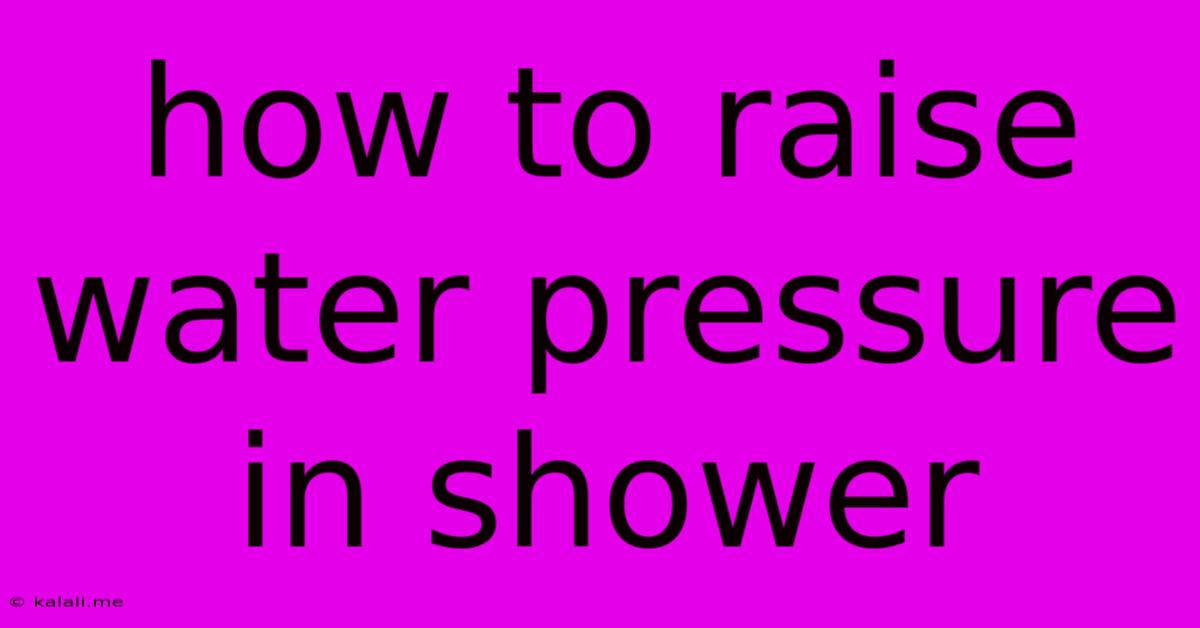How To Raise Water Pressure In Shower
Kalali
May 19, 2025 · 3 min read

Table of Contents
How to Raise Water Pressure in Your Shower: A Comprehensive Guide
Low water pressure in your shower can be incredibly frustrating. A weak, sputtering shower can ruin your morning routine and leave you feeling less than refreshed. Luckily, there are several things you can do to boost that pressure and get the invigorating shower you deserve. This guide explores various solutions, from simple fixes to more involved plumbing adjustments.
Understanding Low Water Pressure: Before diving into solutions, it's important to understand the causes of low water pressure. This could stem from issues within your home's plumbing system, problems with the showerhead itself, or even wider issues with your water supply. Identifying the root cause is crucial for effective troubleshooting. Common culprits include mineral buildup, clogged pipes, a faulty pressure regulator, or even low water pressure from the main water supply.
Simple Fixes for Low Shower Pressure:
These quick solutions are easy to implement and often resolve the problem without requiring any extensive plumbing knowledge:
-
Check the Showerhead: The most common culprit is a clogged showerhead. Mineral deposits and sediment can restrict water flow, significantly reducing pressure. Remove the showerhead and soak it in white vinegar for a few hours, or use a small brush to clean out any debris. A thorough cleaning often restores pressure dramatically.
-
Inspect the Shower Arm: Sediment can build up in the shower arm as well, restricting water flow. If cleaning the showerhead doesn't solve the problem, check the shower arm connection for any blockages. Sometimes, simply tightening the connection can improve water flow.
-
Examine the Water Meter: If you suspect a problem with the main water supply, check your water meter for unusual readings or any signs of leakage. A low reading might indicate a broader issue affecting your entire home's water pressure.
More Involved Solutions for Increased Shower Pressure:
If the simple fixes don't work, you may need to address more complex plumbing issues:
-
Replace the Showerhead: An old, inefficient showerhead can significantly reduce water pressure. Replacing it with a low-flow showerhead designed for high pressure might seem counterintuitive, but many modern models are engineered to improve water pressure while conserving water. Look for models with a higher flow rate (gallons per minute or GPM).
-
Check the Pressure Regulator: A pressure regulator is designed to maintain consistent water pressure throughout your home. If it's malfunctioning or set too low, it can restrict water pressure to your shower. You might need a plumber to assess and adjust or replace this component.
-
Address Clogged Pipes: Severe mineral buildup or sediment can significantly restrict water flow throughout your pipes. This often requires professional help from a plumber, potentially involving hydro-jetting to clear out the blockages. Preventing this build-up involves regular maintenance and using water softeners.
-
Increase Water Main Pressure (If Applicable): In some cases, low water pressure is a result of low pressure from the main water supply. This often involves contacting your local water authority to investigate.
Preventing Future Low Water Pressure Issues:
Regular maintenance is key to preventing low shower pressure problems. These preventative measures can help ensure you continue to enjoy a powerful shower:
-
Regular Showerhead Cleaning: Make it a habit to clean your showerhead every few months. A quick soak in vinegar can prevent buildup and maintain optimal water flow.
-
Water Softener Installation: If you live in an area with hard water, consider installing a water softener. This will significantly reduce mineral deposits and prevent clogs in your showerhead and pipes.
-
Periodic Plumbing Inspection: Schedule regular plumbing inspections to identify and address potential issues before they become major problems. Early detection can prevent costly repairs down the line.
By systematically addressing these potential issues, you should be able to significantly improve the water pressure in your shower. Remember that if you are uncomfortable tackling any plumbing work yourself, it's always best to consult a qualified plumber. They can accurately diagnose the problem and provide effective and safe solutions.
Latest Posts
Latest Posts
-
Integral Of 1 X 3 1
May 19, 2025
-
How To Stop Cats Fighting With Neighbours Cat
May 19, 2025
-
Ping Tcp Packet In Cisco Packet Tracer Using Cmd
May 19, 2025
-
What Does And Mean In Spanish
May 19, 2025
-
This Connection Is Not Private Safari
May 19, 2025
Related Post
Thank you for visiting our website which covers about How To Raise Water Pressure In Shower . We hope the information provided has been useful to you. Feel free to contact us if you have any questions or need further assistance. See you next time and don't miss to bookmark.